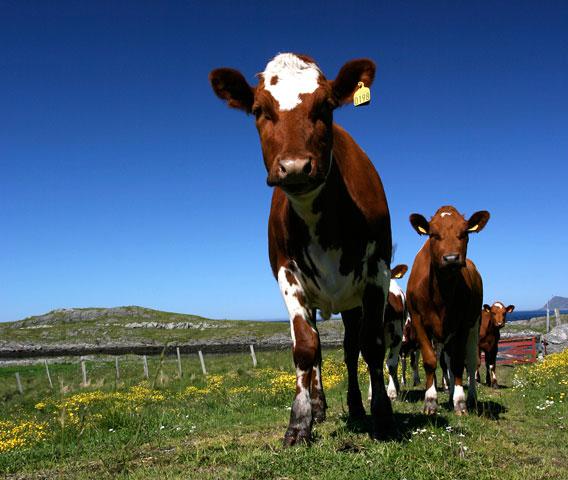The occasional spree killing aside, Norway normally only makes it into the American press as a lighthearted human interest story. Back in the spring of 2010, for example, when the Eyjafljallajökull eruption stranded Prime Minister Jens Stoltenberg in New York, there was much joy over the spectacle of him calmly running the country via iPad from his hotel room. Today, Norway is back in the news for its nationwide butter shortage, a story so silly it was brought to America’s attention by the Colbert Report.
It seems more than a little absurd for one of the richest countries on earth (per capita of GDP, only Luxembourg and tiny Liechtenstein have it beat) to be rationing a basic household commodity, which is what’s happening . But behind this silly story are several important economic lessons about trade and the surprising economic dilemmas posed by striking it rich.
Let’s start with trade. Norway is tiny—more people live in Colorado or Cook County—and it has very marginal agricultural climate. They had some bad weather this summer, hurting the small dairy industry. It’s easy to see how that could lead to reduced national butter output and shortages. Except small places don’t normally try to produce everything themselves: That’s a stupid and wasteful strategy in a global economy. If Norway can’t make enough butter for everyone to slather on their eller mørkt rugbrød, shouldn’t they just import butter from abroad? The supermarket downstairs from my apartment has plenty of butter. Surely we could ship some to Oslo. The problem is that the Norwegian dairy cooperative Tine has a de facto monopoly on the domestic market and is deliberately sheltered from foreign competition (PDF) as a matter of public policy.
The Norwegian government, conscious of how embarrassing and annoying this butter shortage is, is relaxing the high tariffs on imported butter in order to relieve the crisis. It will take some time for supplies to actually begin flowing into the country, but soon enough foreign butter will flood the Norwegian market (as it already has in Sweden, which was afflicted by similar weather problems), and the Great Butter Shortage will vanish from the headlines.
But before concluding that the butter crisis is a simple lesson about the virtues of free trade, it’s worth considering the reasons for adopting these rules in the first place.
Old-fashioned interest-group lobbying plays a role, no doubt, but there’s something deeper at work. Norway got rich through the discovery of offshore oil and gas reserves, a bonanza of natural resource wealth. But with such wealth can come problems, most notably the so-called “Dutch Disease” that afflicted the Netherlands after its own fossil-fuel find.* A capital-intensive industry that employs relatively few workers became a major export industry. The high volume of natural resource exports pushes up the value of the currency and makes it cheap to buy products from abroad. This, in turn, tends to put all domestic producers of other tradable goods out of business and leave your economy dangerously dependent on the fluctuations of the commodity markets.
In principle, economic orthodoxy would say not to sweat it. Just use the natural resources to generate government revenue, then engage in massive redistribution. To many, though, there’s something depressing about the idea of a whole nation living on the dole. What’s more, many Persian Gulf states who’ve de facto taken this approach have realized over time that it creates problems. Your country is rich, superficially, but it lacks the human capital and organizational skills typical of a modern developed country. When the oil runs out, what will you be left with?
Protecting select product markets from international competition has, for this reason, played a major role in Norwegian economic strategy. The inefficiencies involved in blocking foreign butter are minor at most times, can be relaxed in an emergency, and preserve some kind of non-oil economic base for the future.
The largest Norwegian effort in this regard, however, is something more innovative. A large share of the oil revenues, rather than subsidizing current government operations, is invested via the Norwegian Government Pension Fund, which is thought to own approximately 1 percent of the publicly traded stock in the world. In part, the purpose of the fund is, as its website says, “to safeguard and build financial wealth for future generations,” but this could be accomplished by directly giving the funds to Norwegians instead. The real purpose of holding the wealth in a fund that invests exclusively abroad is to limit the appreciation of the krone in international currency markets and maintain Norway’s industrial competitiveness. What it has in common with the butter tariffs, however, is that Norwegians are accepting lower living standards than they might otherwise enjoy for the sake of a long-term strategy of not becoming a Saudi-style oil monoculture.
So laugh it up this week if you see another story about Russian butter smugglers making their way to Oslo. Just remember that there are a lot of small oil-rich countries out there, and Norway is the most politically and socially functional of them all, thanks largely to the very ideas that saddled them with this amusing shortage.
Correction, Dec. 15, 2011: This article originally stated that the “Dutch Disease” was caused by an offshore gas find. The field is onshore. (Return to the corrected sentence.)
